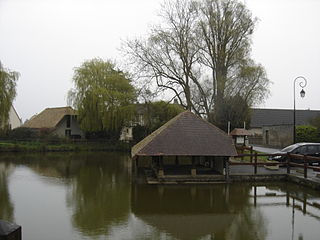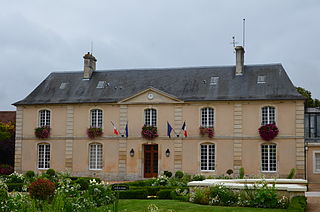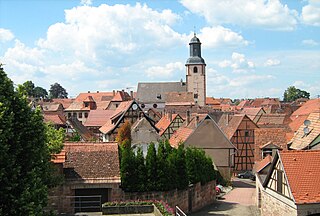
-hou or hou is a place-name element found commonly in the Norman toponymy of the Channel Islands and continental Normandy.

-hou or hou is a place-name element found commonly in the Norman toponymy of the Channel Islands and continental Normandy.
Its etymology and meaning are disputed, but most specialists think it comes from Saxon or Anglo-Saxon hōh "heel", sometimes hō, then "heel-shaped promontory", "rocky steep slope", "steep shore". [1] [2] [3] This toponymic appellative appears as a final -hou or associated with the Romance definite article le Hou. It can be found everywhere in Normandy, but more in the western part of it.
The English toponymy uses this Saxon or Anglo-Saxon element the same way, but its result is phonetically -hoo or -hoe, sometimes -(h)ow or -ho e. g. : Northoo (Suffolk); Poddinghoo (Worcestershire); Millhoo (Essex); Fingringhoe (Essex); Rainow (Cheshire); Soho (London); etc. [4] As an independent element it is Hoe, Hoo, Hooe, Ho or the Hoe, e.g. the Hoe at Plymouth (Dorset) above the harbour.
In Normandy, it may have sometimes mixed up with Old Norse hólmr, meaning a small island, and often found anglicised elsewhere as "holm". It can still be found in modern Scandinavian languages, e.g. Stockholm. The normal evolution of hólmr in Normandy is -homme, -houme, even -onne at the end of a toponym and le Homme, le Houlme, le Hom with the article. The Norman toponym and diminutive hommet / houmet also derives from this element.
In Parisian French, the equivalent is îlot, which is cognate with the English "islet".


See Huttoft, England
The toponymy of England derives from a variety of linguistic origins. Many English toponyms have been corrupted and broken down over the years, due to language changes which have caused the original meanings to be lost. In some cases, words used in these place-names are derived from languages that are extinct, and of which there are no known definitions. Place-names may also be compounds composed of elements derived from two or more languages from different periods. The majority of the toponyms predate the radical changes in the English language triggered by the Norman Conquest, and some Celtic names even predate the arrival of the Anglo-Saxons in the first millennium AD.

Authie is a commune in the Calvados department in the Normandy region of north-western France.

Bavent is a commune in the Calvados department in the Normandy region of north-western France.

Cairon is a commune in the Calvados department in the Normandy region in northwestern France.

Cormelles-le-Royal is a commune in the Calvados department in the Normandy region in northwestern France.

Honfleur is a commune in the Calvados department in northwestern France. It is located on the southern bank of the estuary of the Seine across from Le Havre and very close to the exit of the Pont de Normandie. The people that inhabit Honfleur are called Honfleurais.

Saint-Manvieu-Norrey is a commune in the Calvados department in the Normandy region in northwestern France.

Norman or Norman French is a French dialect which can be classified as a langue d'oïl. The name "Norman French" is sometimes also used to describe the administrative languages of Anglo-Norman and Law French used in England. For the most part, the written forms of Norman and modern French are mutually intelligible. The thirteenth-century philosopher Roger Bacon was the first to distinguish it along with other dialects such as Picard and Bourguignon. Today, although it does not enjoy any official status, some reports of the French Ministry of Culture have recognized it as one of the regional languages of France.
Thorp is a Middle English word for a hamlet or small village.

Saint-Vaast-la-Hougue is a commune in the Manche department in Normandy in north-western France.

Granville is a commune in the Manche department and region of Normandy, northwestern France. The chef-lieu of the canton of Granville and seat of the Communauté de communes de Granville, Terre et Mer, it is a seaside resort and health resort of Mont Saint-Michel Bay, at the end of the Côte des Havres, a former cod-fishing port and the first shellfish port of France. It is sometimes nicknamed "Monaco of the North" by virtue of its location on a rocky promontory.
Germanic toponyms are the names given to places by Germanic peoples and tribes. Besides areas with current speakers of Germanic languages, many regions with previous Germanic speakers or Germanic influence had or still have Germanic toponymic elements, such as places in France, Wallonia, Poland, Northern Portugal, Spain and Northern Italy.
The various toponyms in the historical region of Lorraine are often known by very different names depending on the language in which they are expressed. This article provides an understanding of the linguistic and historical origin of this diversity and lists a number of correspondences for communes and lesser localities in the four departments of the former region: Meuse, Meurthe-et-Moselle, Moselle, and Vosges.

The Écréhous are a group of islands and rocks situated six miles (9.6 km) north-east of Jersey, and eight miles (12.8 km) from France. They form part of the Bailiwick of Jersey and are administratively part of the Parish of St Martin.
Óslác is a theophoric Anglo-Saxon given name, cognate to Old Norse Ásleikr/Áslákr and to Old High German Ansleh. It is composed of ós "god" and lác "play, sport; offering, sacrifice".

Bouxwiller is a commune in the Bas-Rhin department, Alsace, Grand Est, northeastern France. Likely meaning "Bucco's land", Bouxwiller is the capital of the Bouxwiller canton and is located within the Saverne arrondissement about 34 kilometres (21 mi) northwest of Strasbourg.

Bouxwiller is a commune in the Haut-Rhin department, Alsace, Grand Est, France.
There are numerous islands containing the word holm, mainly in northern Europe. In many cases the name is derived from the Old Norse holmr, meaning "a small and rounded islet". These include:

Placenames in Normandy have a variety of origins. Some belong to the common heritage of the Langue d'oïl extension zone in northern France and Belgium; this is called "Pre-Normanic". Others contain Old Norse and Old English male names and toponymic appellatives. These intermingle with Romance male names and place-name elements to create a very specific superstratum, typical of Normandy within the extension zone of the Langue d'oïl. These are sometimes called "Normanic".

Jersey, officially the Bailiwick of Jersey, is a British crown dependency.